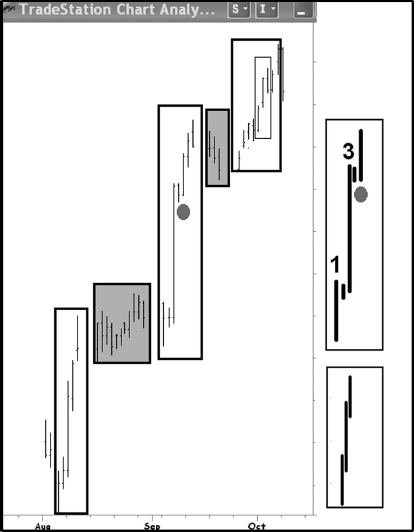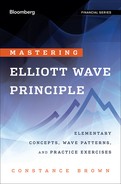Using Fewer Bars to Represent Complete Impulse Waves
You are learning several things by using boxes. The boxes force you to examine the internal structure and you have learned that every five-wave move can further subdivide waves 1, 3, and 5 into five smaller waves. When you look at waves in different time horizons they can display more or fewer bars because time expands and contracts. I have discovered most new to the Elliott Wave Principle will get this question wrong.
How many bars does it take to illustrate a five-wave move?
Figure 2.4 shows a 120-minute bar chart of the S&P 500. Not only are the three impulse waves contained within boxes (clear), but the corrective waves are in boxes as well (gray). You need to study the internals of these three impulse waves in the clear boxes. They all have five-wave internals. The first box is the easiest. The middle box for wave 3 will be difficult if you do not realize the bars above the gray dot create a small five-wave pattern to end wave 3. Wave 5 subdivided into its own smaller pattern of five-waves. If I went up to a longer time horizon the entire five-wave move might look like the right-hand insert that contains the same gray dot in Figure 2.4. Some of the bars compress into the new time horizon. It does not change the wave interpretation.
FIGURE 2.4 Five-Wave Structures
Source: Aerodynamic Investments Inc., © 1996–2012, Advanced Trading Seminar, www.aeroinvest.com; TradeStation.

Now we need to be more formal with the rules.
1. Wave 3 cannot be the shortest. That means if wave 3 and wave 1 are the same length, wave 5 would have to be shorter than both. Wave 3 does not have to be the longest. Somehow people twist this rule. Just don’t make wave 3 the shortest in comparison to waves 1 and 5.
2. Wave 4 cannot retrace into the range of wave 1. There is going to be an exception to this rule later, but it is a pattern we have not discussed yet.
3. The Wave Principle has a guideline demonstrated in Figure 2.4. Guidelines are observations that are often repeatable. They do not create hard and fast rules, however. When you look at the corrective waves in gray box 2 and 4, one is about half the size of the other. This is the guideline of alternation. If the wave in the second position takes a long time to develop, the fourth wave will likely form in less time. If the second wave is complex in appearance, the fourth wave might just be very simple. The opposite applies when the second wave is simple and/or takes little time to develop. These alternating characteristics between corrective waves can be exceedingly helpful. Neither of the compressed insets in the right margin of Figure 2.4 illustrates the guideline of alternation.
Returning to Figure 2.4, look at the more detailed chart with five boxes. All rules remain valid. Now look at the upper insert on the right margin with a gray dot. Using only five bars I can easily represent a fully qualified five-wave swing. The gray dot ends wave 4 and it does not enter the range travelled by wave 1. The fifth wave in this bar chart is just a straight single line that moves up from the gray dot. We know our rules that impulse waves must subdivide into five waves so well that we no longer have to be shown all the subdivisions. We know they are impulse waves with five-wave internals because the fourth wave does not fall into the range travelled by the first wave and the third is not the shortest. So with five bars I know there is a five-wave structure present.
Now look at the bottom insert in the margin of Figure 2.4. If I took the bar chart in the upper insert and changed it from a weekly chart to a two-week chart, the lower insert is how the data would appear. With just three simple bars I can obtain a five-wave swing. The third wave is not the shortest. There are three impulsive waves. There are two corrective waves. Really, you may ask? Yes. The third bar retraces a portion of the first bar. Therefore, I know a second wave is present. The same can be said for the fourth wave being present because the third bar retraced a portion of the middle bar. I also know the fourth wave did not retrace the third to such an extent the range of the first bar was challenged. The middle bar is not the shortest. These three bars exhibit all the rules necessary to identify it as a complete five-wave structure.
Knowing that these three figures in Figure 2.4 all represent complete and legitimate five-wave patterns is critical in developing your skills to interpret wave patterns in any time horizon.
We have discussed only simple and extending five-wave patterns up to this point. Now we need to move forward to see how to determine if an extending five-wave pattern is complete or not. Extending impulse waves are much harder to work with than many think. It can be made much easier when you know where to start your wave interpretation.
